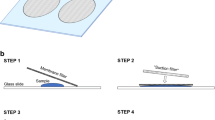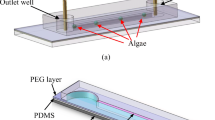Abstract
In this study, a fast bioassay using the ECOTOX system to evaluate biological safety of waste water samples from different sources was performed. This biological system works full automatically to test water quality. The system uses the image analysis of movement behavior of the flagellate Euglena gracilis as a model organism. The measured parameters are cell motility, velocity, orientation (r-value, upward swimming and alignment) as well as cell form (compactness). In most tested waste samples, precision of orientation (r-value) is inhibited at concentrations which showed less effect on the other parameters. Motility and compactness were noticed to be the least inhibited parameters in response to waste water samples. The results of waste treatment plants revealed the efficiency of the used purification system. Movement as well as orientation parameters in E. gracilis showed high sensitivity toward chlorine. The order of sensitivity was motility > velocity > r-value > upward swimming with EC50 values of 0.69, 0.81, 0.85, and 1.78 mg L−1, respectively. ECOTOX with its test organism (E. gracilis) provides an automatic, fast and sensitive system to monitor water samples.











Similar content being viewed by others
References
Acher, A., Fischer, E., Turnheim, R., & Manor, Y. (1997). Ecologically friendly wastewater disinfection techniques. Water Research, 31(6), 1398–1404.
Batterman, S., Zhang, L., & Wang, S. (2000). Quenching of chlorination disinfection by-product formation in drinking water by hydrogen peroxide. Water Research, 34(5), 1652–1658.
Bayo, J., Angosto, J. M., & Gómez-López, M. D. (2009). Ecotoxicological screening of reclaimed disinfected wastewater by Vibrio fischeri bioassay after a chlorination–dechlorination process. Journal of Hazardous Materials, 172(1), 166–171.
Blinova, I. (2000). The perspective of microbiotests application to surface water monitoring and effluents control in Estonia. Environmental Toxicology, 15, 385–389.
Blinova, I. (2004). Use of freshwater algae and duckweeds for phytotoxicity testing. Environmental Toxicology, 19, 425–428.
Brungs, W. A. (1973). Effects of residual chlorine on aquatic life. Journal Water Pollution Control Federation, 45(10), 2180–2193.
Burhenne, M. (2000). Biotestsystem mit Bodenalgen zur ökotoxikologischen Bewertung von Schwermetallen und Pflanzenschutzmitteln am Beispiel von Cadmium und Isoproturon. PhD Thesis, Humboldt-Universität zu Berlin.
Cantor, K. P., Lynch, C. F., Hildesheim, M. E., Dosemeci, M., Lubin, J., Alavanja, M., et al. (1998). Drinking water source and chlorination byproducts I. Risk of bladder cancer. Epidemiology, 21–28.
Chambers, P. A., Allard, M., Walker, S. L., Marsalek, J., Lawrence, J., Servos, M., et al. (1997). The impacts of municipal wastewater effluents on Canadian waters: a review. Water Quality Research Journal of Canada, 32(4), 659–713.
Chandra, S., Chauhan, L. K. S., Murthy, R. C., Saxena, P. N., Pande, P. N., & Gupta, S. K. (2005). Comparative biomonitoring of leachates from hazardous solid waste of two industries using Allium test. The Science of the Total Environment, 347(1–3), 46–52.
Checcucci, A., Colombetti, G., Ferrara, R., & Lenci, F. (1976). Action spectra for photoaccumulation of green and colorless Euglena: evidence for identification of receptor pigments. Photochemistry and Photobiology, 23, 51–54.
Danilov, R. A., & Ekelund, N. G. A. (1999). Influence of waste water from the paper industry and UV-B radiation on the photosynthetic efficiency of Euglena gracilis. Journal of Applied Phycology, 11, 157–163.
Elimelech, M. (2006). Special paper—the global challenge for adequate and safe water. Aqua-Journal of Water Supply, 55(1), 3–10.
El-Shehawi, A. M., Ali, F. K., & Seehy, M. A. (2007). Estimation of water pollution by genetic biomarkers in tilapia and catfish species shows species–site interaction. African Journal of Biotechnology, 6(7), 840–846.
Emmens, C. W. W. (1940). The dose/response relation for certain principles of the pituitary gland, and of the serum and urine of pregnancy. The Journal of Endocrinology, 2, 194–225.
Fianko, J. R., Osae, S., Adomako, D., Adotey, D. K., & Serfor-Armah, Y. (2007). Assessment of heavy metal pollution of the Iture estuary in the central region of Ghana. Environmental Monitoring and Assessment, 131, 467–473.
Gadgil, A. (1998). Drinking water in developing countries. Annual Review of Energy and the Environment, 23(1), 253–286.
Ganoulis, J. G. (2009). Risk analysis of water pollution. Weinheim: Wiley.
Gopala, K., Tripathyb, S. S., Bersillonb, J. L., & Dubeya, S. P. (2007). Chlorination byproducts, their toxicodynamics and removal from drinking water. Journal of Hazardous Materials, 140(1–2), 1–6.
Gueguen, C., Gilbin, R., Pardos, M., & Dominik, J. (2004). Water toxicity and metal contamination assessment of a polluted river: the Upper Vistula River (Poland). Applied Geochemistry, 19, 153–162.
Häder, D.-P., Richter, P., Schuster, M., Daiker, V., & Lebert, M. (2009). Molecular analysis of the graviperception signal transduction in the flagellate Euglena gracilis: involvement of a transient receptor potential-like channel and a calmodulin. Advances in Space Research, 43(8), 1179–1184.
Halim, Y., & Abou Shouk, F. (2010). http://www.unesco.org/csi/pub/source/alex8.htm.
Hou, W., Chen, X., Song, G., Wang, Q., & Chang, C. C. (2007). Effects of copper and cadmium on heavy metal polluted waterbody restoration by duckweed (Lemna minor). Plant Physiology and Biochemistry, 45, 62–69.
Jafari, N. G., & Gunale, V. R. (2006). Hydrobiological study of algae of an urban freshwater river. Journal of Applied Sciences and Environmental Management, 10(2), 153–158.
Joubert, G. (1980). A bioassay application for quantitative toxicity management using the green algae, Selenastrum Capricornutum. Water Research, 14, 1759–1763.
Jyoti, K. K., & Pandit, A. B. (2004). Ozone and cavitation for water disinfection. Biochemical Engineering Journal, 18(1), 9–19.
Kelly, C. J., Tumsaroj, N., & Lajoie, C. A. (2004). Assessing wastewater metal toxicity with bacterial bioluminescence in a bench-scale wastewater treatment system. Water Research, 38, 423–431.
Kim, J., Chung, Y., Shin, D., Kim, M., Lee, Y., Lim, Y., et al. (2003). Chlorination by-products in surface water treatment process. Desalination, 151(1), 1–9.
Lah, B., Malovrth, M., Cepeljnik, T., & Marinsek-Logar, R. (2004). Detection and quantification of genotoxicity in wastewater-treated Tetrahymena thermophila using comet assay. Environmental Toxicology, 19, 545–553.
Lanciotti, E., Galli, S., Limberti, A., & Giovannelli, L. (2004). Ecotoxicological evaluation of wastewater treatment plant effluent discharges: a case study in Prato (Tuscany, Italy). Annali di Igiene, 16(4), 549–558.
Lasheen, M. R., & Ammar, N. S. (2009). Speciation of some heavy metals in River Nile sediments, Cairo, Egypt. The Environmentalist, 29(1), 8–16.
Lewis, M. A. (1995). Use of freshwater plants for phytotoxicity testing: a review. Environmental Pollution, 87, 319–336.
Li, M., Hu, C., Gao, X., Xu, Y., Qian, X., Brown, M. T., et al. (2009). Genotoxicity of organic pollutants in source of drinking water on microalga Euglena gracilis. Ecotoxicology, 18(6), 669–676.
Martín-Domínguez, A., Alarcón-Herrera, M. T., Martín-Domínguez, I. R., & González-Herrera, A. (2005). Efficiency in the disinfection of water for human consumption in rural communities using solar radiation. Solar Energy, 78(1), 31–40.
Massoud, A. H. S. (2003). Impact of diffuse pollution on the socio-economic development opportunities in the costal Nile delta lakes. Diffuse Pollution Conference, 17-22 August 2003, University College, Dublin, Ireland.
Matta, C. A., Kheirallah, A.-M. M., Abdelmeguid, N. E., & Abdel-Moneim, A. M. (2007). Effects of water pollution in lake Mariut on gonadal free amino acid compositions in Oreochromis niloticus fish. Pakistan Journal of Biological Sciences, 10(8), 1257–1263.
Morin, S., Duong, T. T., Dabrin, A., Coynel, A., Herlory, O., Baudrimont, M., et al. (2008). Long-term survey of heavy-metal pollution, biofilm contamination and diatom community structure in the Riou Mort watershed, South-West France. Environmental Pollution, 151, 532–542.
Nriagu, J. O., & Pacyna, J. M. (1988). Quantitative assessment of worldwide contamination of air, water and soils by trace metals. Nature, 333, 134–139.
Paixão, S. M., Silva, L., Fernandes, A., O'Rourke, K., Mendonça, E., & Picado, A. (2008). Performance of a miniaturized algal bioassay in phytotoxicity screening. Ecotoxicology, 17, 165–171.
Radwan, K. H., & Ramanujam, T. K. (1997). Studies on organic removal of 2, 4-dichlorophenol wastewaters using a modified RBC. Bioprocess and Biosystems Engineering, 16(4), 219–223.
Rehman, A., Shakoori, R. F., & Shakoori, A. R. (2006). Heavy metal resistant Distigma proteus (Euglenophyta) isolated from industrial effluents and its possible role in bioremediation of contaminated wastewaters. Springer Science + Business Media B V.
Richardson, S. D. (2003). Disinfection by-products and other emerging contaminants in drinking water. Trends in Analytical Chemistry, 22(10), 666–684.
Richter, P., Ntefidou, M., Streb, C., Lebert, M., & Häder, D.-P. (2002). Physiological characterization of gravitaxis in Euglena gracilis. Journal of Gravitational Physiology, 9, 279–280.
Richter, P. R., Ntefidou, M., Streb, C., Faddoul, J., Lebert, M., & Häder, D.-P. (2002). High light exposure leads to a sign change of gravitaxis in the flagellate Euglena gracilis. Acta Protozoologica, 41, 343–351.
Saad, M. A. H., Ezzat, A. A., El-Rayis, O. A., & Hafez, H. (1981). Occurrence and distribution of chemical pollutants in lake Mariut, Egypt. II. Heavy metals. Water, Air, and Soil Pollution, 16, 401–407.
Schlösser, U. G. (1994). SAG—Sammlung von Algenkulturen at the University of Göttingen. Catalogue of strains 1994. Botanica Acta, 107, 113–186.
Schuler, L. J., Hoang, T. C., & Rand, G. M. (2008). Aquatic risk assessment of copper in freshwater and saltwater ecosystems of South Florida. Ecotoxicology, 17, 642–659.
Shishida, K., Echigo, S., Kosaka, K., Tabasaki, M., Matsuda, T., Takigami, H., et al. (2000). Evaluation of advanced sewage treatment processes for reuse of wastewater using bioassays. Environmental Technology, 21(5), 553–560.
Shuttleworth, K. L., & Unz, R. F. (1988). Growth of filamentous bacteria in the presence of heavy metals. In D. Jenkins & B. H. Olson (Eds.), Water and wastewater microbiology (pp. 485–487). Oxford: Pergamon.
Starr, R. C. (1964). The culture collection of algae at Indiana University. American Journal of Botany, 51, 1013–1044.
Streb, C., & Häder, D.-P. (2003). Risk assessment with the biomonitoring system ECOTOX. ConSoil 2003, 8th International FZK/TNO Conference on Contaminated Soil, Conference Proceedings, Gent, Belgium, May 12-16 2003. FZK/TNO and OVAM, Belgium, 1-10.
Streb, C., Richter, P., Sakashita, T., & Häder, D.-P. (2002). The use of bioassays for studying toxicology in ecosystems. Current Topics in Plant Biology, 3, 131–142.
Tahedl, H., & Häder, D.-P. (1999). Fast examination of water quality using the automatic biotest ECOTOX based on the movement behavior of a freshwater flagellate. Water Research, 33, 426–432.
Tahedl, H., & Häder, D.-P. (2001). Automated biomonitoring using real time movement analysis of Euglena gracilis. Ecotoxicology and Environmental Safety, 48, 161–169.
Vidal, A., & Diaz, A. I. (2000). High-performance, low-cost solar collectors for disinfection of contaminated water. Water Environment Research, 271-276.
Villanueva, C. M., Fernandez, F., Malats, N., Grimalt, J. O., & Kogevinas, M. (2003). Meta-analysis of studies on individual consumption of chlorinated drinking water and bladder cancer. British Medical Journal, 57(3), 166.
Walsh, G. E., & Garnas, R. L. (1983). Notes. Determination of bioactivity of chemical fractions of liquid wastes using freshwater and saltwater algae and crustaceans. Environmental Science & Technology, 17(3), 180–182.
Wong, S. L., Wainwright, J. F., & Pimenta, J. (1995). Quantification of total and metal toxicity in wastewater using algal bioassays. Aquatic Toxicology, 31(1), 57–75.
Wong, S. L., Nakamoto, L., & Wainwright, J. F. (1997). Detection of toxic organometallic complexes in wastewaters using algal assays. Archives of Environmental Contamination and Toxicology, 32(4), 358–366.
World Resources Institute. (1996). World Resources Institute, the United Nations Environment Programme, the United Nations Development Programme, and the World Bank. New York: Oxford University Press.
Yang, C. Y., Chiu, H. F., Cheng, M. F., & Tsai, S. S. (1998). Chlorination of drinking water and cancer mortality in Taiwan. Environmental Research, 78(1), 1–6.
Acknowledgments
We thank the Deutsche Akademischer Austauschdienst (DAAD) and the government of the Arab Republic of Egypt for granting a scholarship to Hoda Ahmed.
Author information
Authors and Affiliations
Corresponding author
Rights and permissions
About this article
Cite this article
Ahmed, H., Häder, DP. Monitoring of Waste Water Samples Using the ECOTOX Biosystem and the Flagellate Alga Euglena gracilis . Water Air Soil Pollut 216, 547–560 (2011). https://doi.org/10.1007/s11270-010-0552-4
Received:
Accepted:
Published:
Issue Date:
DOI: https://doi.org/10.1007/s11270-010-0552-4




